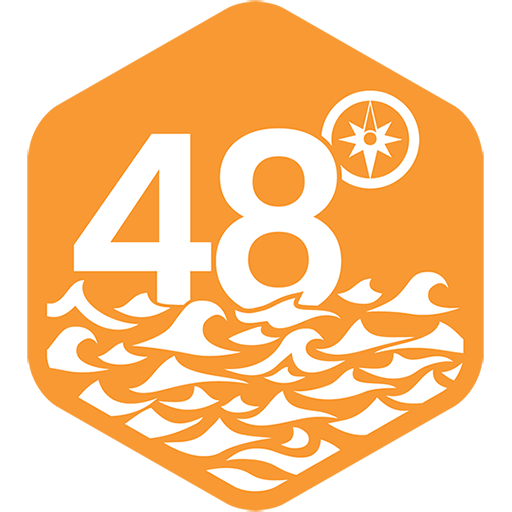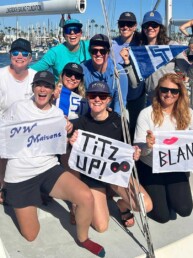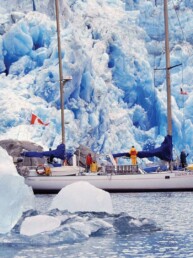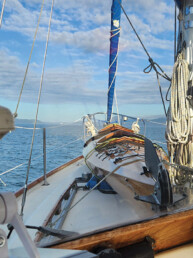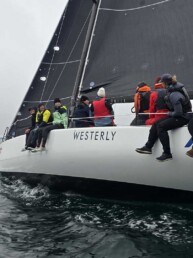Catch this,” said US Sailing Safety at Sea course moderator Captain Jonathan Kabak as he tossed a flare to a student in the recent Safety at Sea hands-on training at Marshall Community Center in Vancouver, Washington. “Read the directions loud and clear so everyone can hear.” Catching the flare was the easy part. Reading the directions, not so much. The student squinted painfully and started in slowly with, “Firrrst…re…moove the…cap.” After this one line, the pain got real, and she had no choice but to find her glasses so she could continue reading the small print. Tick. Tock. Tick. Tock.
This illustration with the emergency handheld flare was just one of the course’s many examples of the importance of knowing how to use the safety devices on our boats before we leave the docks. You can buy a lot of safety stuff, but just because it’s there doesn’t mean that it will prove to be useful in an emergency if you have to stop and read the directions.
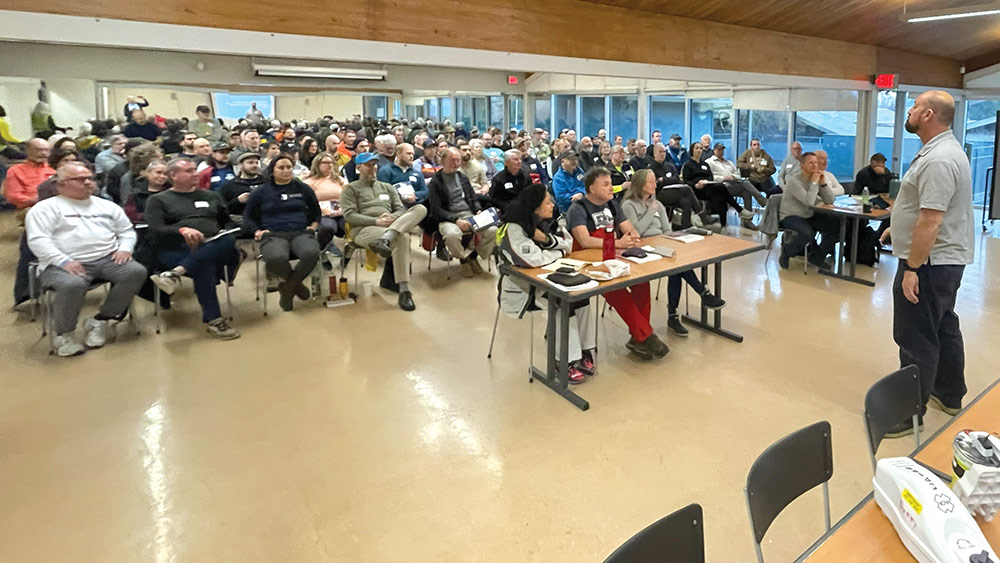
Nuts No More
After many years of putting it off, I finally took the Safety at Sea class and wanted to share my experience. Margaret Pommert, The Sailing Foundation’s VP of Safety at Sea and member of the US Sailing Safety at Sea Committee, had been inviting me to participate since 2021 when we lost an experienced sailor in an overboard incident at Race Week. Like so many of us, I’d been balking at the idea until I had more time. What a mistake that was. The class proved without a doubt that if we think we can buy safety, we’re nuts. And the time to learn about it is right now.
Safety on our boats is something we need to practice, and something we need to know before we ever set out to sea, whether we’re headed inshore or offshore. The class is officially called the US Sailing International Offshore Safety at Sea with Hands-on Training, and anyone who finds themselves on boats—whether sail or power, racing or cruising—would benefit from taking it. Sanctioned by US Sailing, the course is presented locally in the Pacific Northwest by the Sailing Foundation. It is composed of an online class, followed by a day-long hands-on class. The cost is $450, which seemed high to me at registration. But after the class? I would have paid double or more because it really is that good.
Online and In-Person
The online portion is broken into 15 units of pre-recorded videos covering safety topics including safety devices, emergency communications, life raft survival, and more. Students can watch the videos at their own pace, which takes about 12 hours. At the end of each unit, there is a short knowledge test that includes 10 multiple choice questions. To pass, you must score 80% or higher. The online class serves as a prerequisite to the hands-on course where students spend an entire day practicing and reinforcing what’s been learned.
The Safety at Sea course complies with World Sailing’s Offshore Personal Survival Course guidelines, and passing it is a requirement for many local offshore races including the Van Isle 360 and more. As the national governing body for the sport of sailing, US Sailing is the only organization in the United States sanctioned by World Sailing to issue Safety at Sea certificates.
US Sailing updates the curriculum every year to include lessons learned from recent safety incidents, including those for which an Arthur B. Hanson rescue medal was awarded. In turn, the Sailing Foundation updates the hands-on curriculum every year, both to align with the national curriculum and to add new learning opportunities for participants returning for their renewal every five years. With The Sailing Foundation’s legacy as the developer of the Lifesling, they also offered an additional half-day of hands-on training in crew overboard rescue to participants the day before the main course.
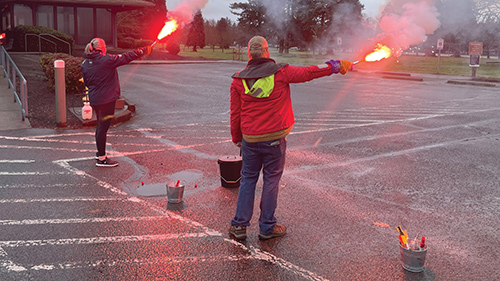
Life On an Island
There are things that happen on boats that don’t happen on land. When you cast your lines from the safety of the dock, you’re basically going out to sea on a tiny island, and whether you’re cruising or racing, this island should be equipped with the tools necessary to keep your crew safe and your island afloat when things go sideways.
Just having the safety equipment on board is not enough. Everyone on board should know how to use it, and the time to learn is not at 3 a.m. when your small island is sinking, there’s a fire on board, you’re dealing with a medical emergency, or your crew is considering abandoning ship.
“Everybody pees, poops, sleeps and eats… and some of us menstruate,” shared Captain Kabak during a particularly sensitive topic involving crew health on board our small islands and the impact medical conditions can have on the safety of the crew. Normalizing conversations around this stuff can seriously keep the crew happy and healthy.
No More Envelopes
Though I’d never heard of it before the class, some crews use the ‘sealed envelope’ method of collecting information about people’s medical conditions before a big race. This is where the crew completes a medical questionnaire that is placed in a sealed envelope and only opened if they have a medical emergency. The problem is that medical issues on boats can put an entire island population at risk, and being open and honest about your ailments before leaving the dock gives a skipper time to evaluate your risk level and decide if the condition can be accommodated and treated on board if this becomes necessary. So, the sealed envelope system is no longer considered a good idea. Knowing your crew and their medical (or potential medical) conditions in advance is vitally important in the event of an emergency.
May Day May Day, I Don’t Know Everything
It’s one thing to read about something, but it’s entirely another thing to experience it. For example, back to the simple handheld flare. How many of us have had to strike and hold a flare? Did you know you should have gloves on for this to avoid getting burned? How about tinted glasses if you want to be able to see immediately following the burn out? How many of us know the difference between a May Day or Pan Pan distress call, and how to make such a call in an emergency? How many of us have ever jumped in the water with all our foulies on, and tested our auto-inflating PFD? How about the proper way to inflate a life raft so it doesn’t get punctured on the boat or float away before everyone is safely inside? How about righting a life raft if it flips over? How do you even get in and out of a life raft safely with all your gear on? Here’s a good one: how many of us have cut super thick rigging using the tools on the boat should we lose the rig and it’s dragging the boat over?
Before the Safety at Sea class, I would have answered every single one of those questions with, “not me.” Like me, you may have spent time reading about boat safety and think you have enough knowledge to get by. But the problem with this thinking is that in an actual emergency at sea, where we’re not in a controlled environment, we may not have the luxury of time on our side to grab our readers and deal with the small print. Knowing this stuff and practicing it beforehand can mean the difference between life and death for ourselves and our crew.
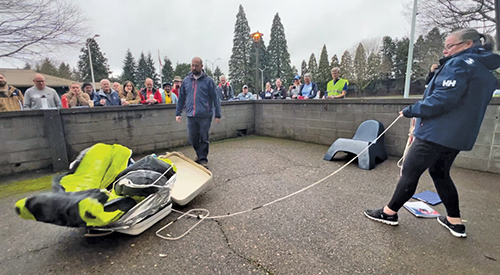
Shelf Life
You may have all the fancy safety gadgets on board, but could be unaware that some need to be serviced or are beyond their expiration date. This is the stuff we don’t think of until there is a real emergency on board. The bottom line is that bad things happen to good people. Boats hit objects out at sea. People have on board medical emergencies. Boat systems fail. There are rig failures. And crews fall overboard. When these things happen—and they will happen—knowing what to do will alleviate panic and potentially save lives.
100 Stories and Please, No More Plugs
There were 100 people participating in the hands-on training day. Esther Goodell from Seattle was there because she is sailing on the TP52 MIST for Van Isle 360 and needed the completion certificate. Kat McCoy of the Catalina 36 Mata Hari was in my group, and she was taking the refresher as her skipper wanted more people on board to have the safety training. High school civics teacher and fourth grade girls’ basketball coach Ginnie Jo Blue is racing Van Isle 360 on the J/99 One Life and said, “I’m a mountain climber, and I just love to suffer!”
For one exercise involving crew assessments of medical emergencies, I got paired up with Race to Alaska sailor Dave White who sailed on Team Monkey Fist in 2023. Here, Dave was pretending to be lying on the deck of the boat complaining of severe lower abdominal pain. I was assigned to figure out if a medical evacuation might be necessary, so I started with the faux assessment. On a scale of 1 to 10 (1 being no pain, and 10 being unbearable pain) Dave shared that he was at a 7. That was certainly a lot of pain. Was he experiencing internal bleeding? A ruptured spleen or appendix? He had no other symptoms such as fever or vomiting. I concluded that Dave needed to get into a comfortable bunk down below while another crew member continued to monitor his condition. Wrong! It was here that the instructor reminded me that the number one question to ask the patient in this type of situation would be, “Dave, when was the last time you pooped?”
Funny, but It turns out that Dave wasn’t bleeding internally and wouldn’t need a USCG medical evacuation after all. He just needed to drink lots of water and get himself to the head! Before the class, I didn’t know what ‘The Plug’ meant. But after the class it was crystal clear. Some racers are uncomfortable using a boat head and so they essentially hold off going number two until they get to their destination and can use a real toilet. Due to the toxic nature of this happenstance, it’s important to normalize the conversation about using the head, and to make sure everyone on board is healthy and making regular visits to the head. Some crews have adopted the gold star board for this reason, and crew members get a gold star for going number one and two gold stars for going number two. You can’t make this stuff up!
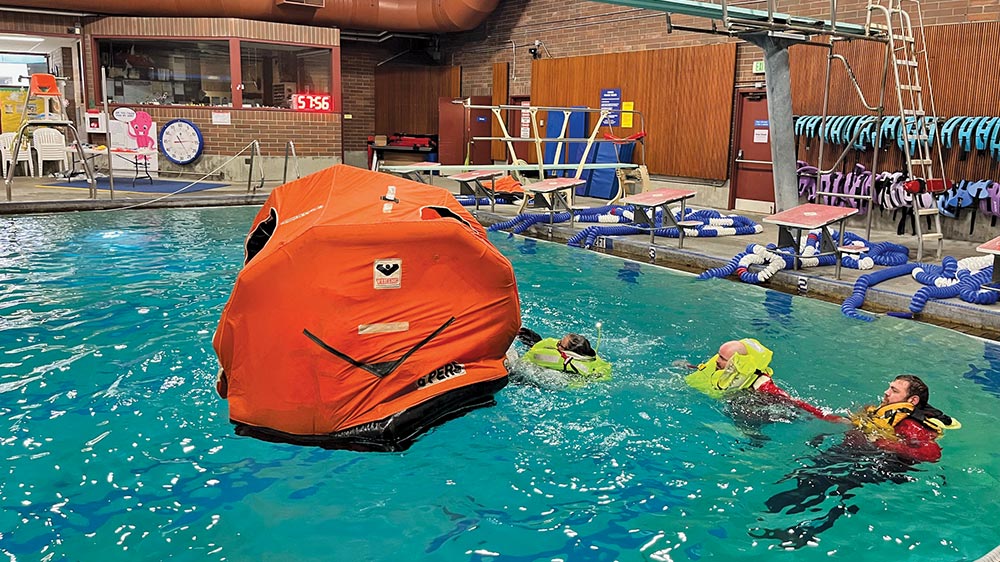
If I’m Not Helping, I’m Dead Weight
At lunch, Dave shared a time he was climbing Mt. Baker and came upon a group of climbers who had given up their summit bids to help a woman and her daughter who were in distress. He was so impressed by how many people put off their own pursuits to help someone in need. Watching this, he realized just how few first aid and safety skills he had to add to the effort. It was here that he decided that he was no longer going to accept being a liability to his team, but rather he would learn as many safety skills as he could so he would be able to help people if they needed it.
I also met Michael Kalahar from Port Angeles who races his J/80 Litonya. He was taking the Safety at Sea course as a refresher and shared that he nearly died following an incident in the Pacific Ocean while cruising from Puerto Vallarta to Tahiti in 2010 on Wind Child, a Beneteau 36s7. They were 400 miles offshore and he was on deck during an accidental jibe, and the mainsheet caught his head and neck and pinned him down only after he banged his head into a winch. This caused his trachea to collapse, and he lost consciousness. As this happened, he bit his tongue in half and could no longer swallow. He was one of six crew on board, and one was a certified EMT, who started CPR while another crew called the Coast Guard for evacuation. Three Air Force para jumpers (PJs) responded and transferred Kalahar to a freighter that was nearby for three days. On board the freighter, the PJs stayed with him and continued treatment for the head injury until they got him back to shore where he was immediately transferred to a hospital.
This incident was clearly a wakeup call that accidents do happen to experienced sailors while at sea. For Kalahar, he lived to tell the story, but had serious PTSD and didn’t go sailing again for five years. With his wife’s encouragement, he got back out there with club racing, and later did Oregon Offshore in 2021, and Swiftsure in 2023. His next race is Van Isle 360, which he is doing with sailmaker and marine business owner, Dan Kaseler, and his team of highly skilled sailors. Kalahar is the designated safety officer on the team and takes his position very seriously. He last took the Safety at Sea class in 2008 and wanted a refresher going into his summer adventure.
Safety First
If you’re on a boat—and whether you are a professional or recreational racer, cruiser, sailor, or power boater—take the class. The rewards are just so great, and with practice, safety first can really be a thing.
International Offshore Safety at Sea Course
Online Curriculum
Presented by the US Sailing Safety at Sea CommitteeUnit 1: Giving Assistance
Unit 2: Personal Safety Gear
Unit 3: Crew Overboard
Unit 4: Emergency Communications
Unit 5: Search and Rescue
Unit 6: Crew Health
Unit 7: Cold Exposure
Unit 8: Care & Maintenance of Safety Equipment
Unit 9: Signaling
Unit 10: Marine Weather
Unit 11: Fire Safety
Unit 12: Heavy Weather
Unit 13: Storm Sails
Unit 14: Damage Control and Repair
Unit 15: Life Raft and SurvivalHands-On Training Sessions
Presented by The Sailing Foundation
- Giving Assistance
- Personal Safety Gear
- Care and Maintenance of Safety Gear
- Fire Safety and Firefighting
- Crew Health
- Damage Control
- Search and Rescue
- Signals and Pyrotechnics
- Emergency Communications
- Pool Training
For more information, and to sign up be notified when the next course is scheduled, visit The Sailing Foundation’s Safety at Sea page: thesailingfoundation.org/what-we-do/safety-at-sea/
Schelleen Rathkopf is the Producer of Race Week, a Director of Pacific Coast Yachting Association, and the Distribution & Advertising Manager of Waggoner Cruising Guide and Ports & Passes. Previously, she served as the Editor of Northwest Yachting magazine, and Event Producer of the Boats Afloat Show on Lake Union in Seattle. Schelleen owns a 56-foot offshore yacht, and lives aboard in Seattle.
